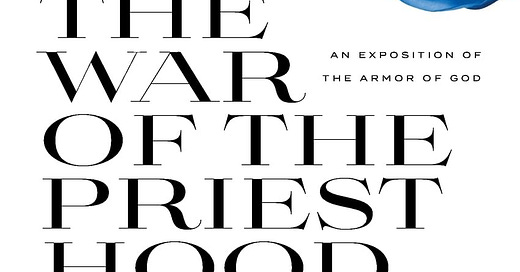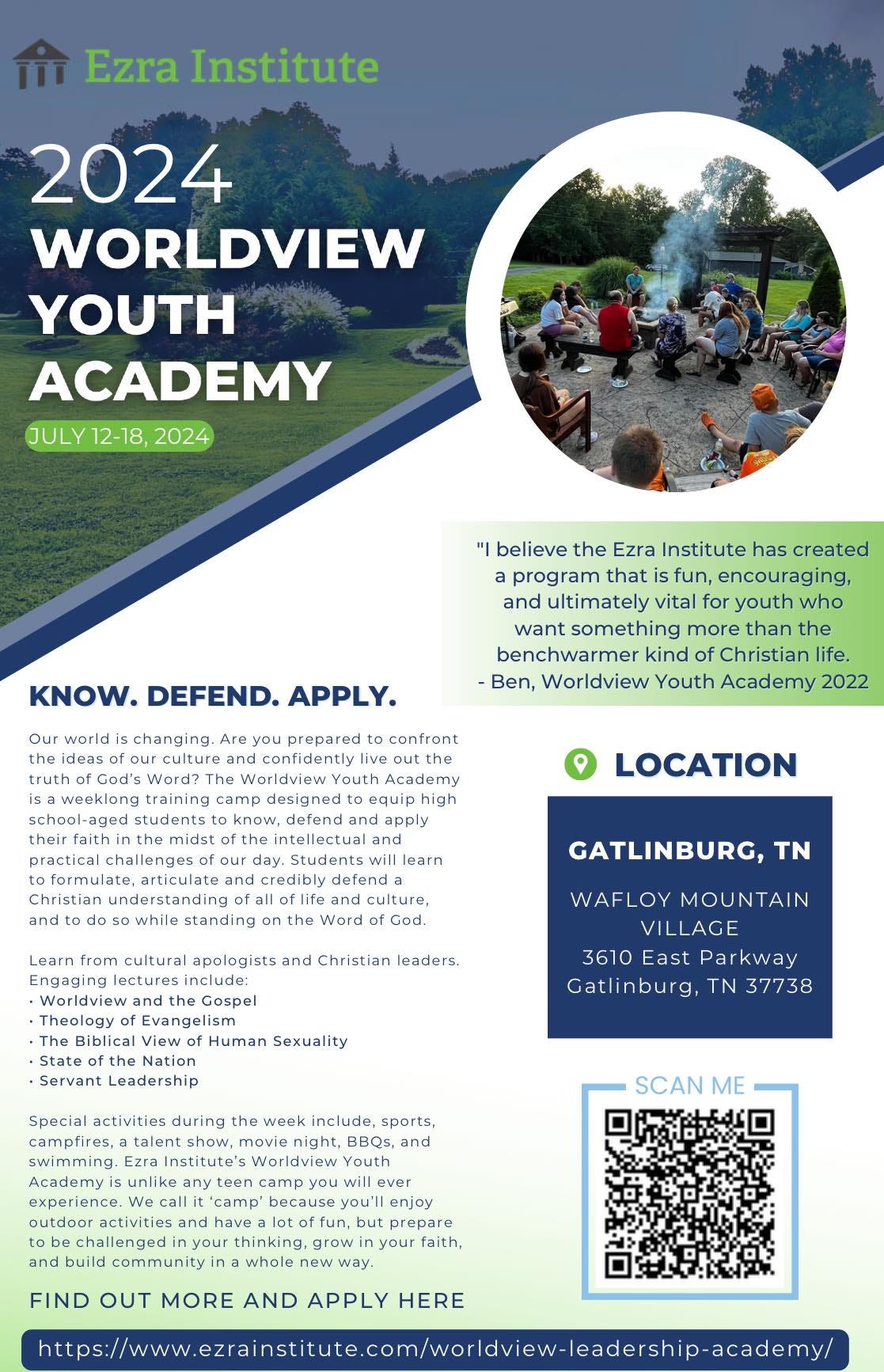Victory by Priesthood
God doesn't give us armor so we can lie down and take a nap. We're called to victory, and Christian priesthood vests us armor extending Christ’s kingdom in the earth before the Second Advent.
Dear friends and supporters:
Many conservative Protestants would find my friend Dr. Uriesou Brito’s latest book The War of the Priesthood perplexing. First, Uri situates priesthood as one of the central themes of the Bible, while for many conservatives it is at best a marginal topic during our new covenant era, limited to the work of Jesus Christ.
Second, they’ve never been exposed to his interpretive method. Uri is obviously operating within the hermeneutical paradigm of David Chilton, James Jordan, and Peter Leithart known as “Interpretive Maximalism” (IM). This is the view that the meaning of biblical language is more extensive and robust than the popular grammatical-historical method of conservative Protestantism gives it credit for. Jim Jordan once pointed out that “the Bible is extremely self-referential”; it carries a unique imbedded interpretive methodology. There are numerous theological threads running throughout the Bible that you will miss if you only skim along the texts’ surface and see its historical meaning alone. The reason we miss these threads, according to IM, is that we miss the Bible’s rich symbolism. If you can’t find the symbolic threads of the Bible, your eyes won’t see the theological fabric God’s trying to show you.
Another way of putting this is to say that our job isn’t to figure out the grammatical-historical meaning of the Bible and then construct a biblical theology from it but, rather, to recognize that theology inheres in the total text itself. Jordan once wrote that there’s a difference between the Christian worldview and the biblical worldview. The Christian worldview is the way of interpreting reality according to distinctly Christian presuppositions. The biblical worldview is the way the Bible itself interprets reality. This biblical worldview is inescapably symbolic and funds the Christian worldview it necessarily generates.
Critics charge IM often rests in speculative eisegesis, but no one may plausibly claim it doesn’t take the text of Scripture with utmost seriousness. Behind IM is the conviction that God has a reason for everything he says, and that he’s often saying more than we think he is.
Uri sees priesthood as one of the central biblical themes, and he sees it throughout the entire Bible. In fact, as I wrote in my blurb, “This book is something of a mini-biblical theology.” In other words, Uri interprets the Bible’s storyline through the lens of priesthood, specifically through the attire/armor of the OT priesthood transmuted into new covenant realities. Jesus is our great high priest, and he alone atoned for our sins, presenting us and our great needs to the Father; but his people are priests in the sense that they do the priestly job of presenting the Triune God to the world, and they are (symbolically but truly) arrayed in priestly attire.
Most of the book is an explanation and application of the armor of God in Ephesians 6, but Uri dissents from the popular conclusion that Paul is patterning the armor message after the Roman soldier’s armor of the time. Rather, he suggests Paul is thinking of the ministerial attire of the OT priest, and he offers biblical support for this minority position. He sees the OT priest’s armor as itself symbolizing deeper realities, that in in turn are transmuted into new covenant truths for all Christians. Uri is at pains to declare that it is Christ himself that is our armor: in putting on Christ (at baptism; see below), we put on his armor.
A Theology of the Feet
Here are a couple of examples of how he sees the attire of the old covenant priesthood as Paul’s assumption of the new covenant armor of the Lord:
Paul’s description of the foot armor as “the readiness given by the gospel of peace” reflects the new covenant transmutation of the old covenant priest’s preparation for kingdom warfare first hinted at Exodus 12:11 at the Passover. While the priesthood as a Jewish liturgical office hadn’t yet been established, the pattern of attire/armor for the feet had been. Moreover, Isaiah 52:7 speaks of the beautiful feet of those who bring the gospel of salvation. Paul invokes this event-enrollment in Romans 10:15 to speak of new covenant Gospel preachers and preaching. In Matthew 10:14 Jesus warns his disciples to shake the dust from their feet if a house refuses to receive them and their message. And it’s with the feet that Christ crushed the head of Satan and that his followers will crush the head of Satan’s followers.
If minimalist interpreters find this view strained, Uri would reply that the Bible posits a “theology of the feet,” and since this theology encompasses specifics in the case of OT priests and applies this theology to the saints in the NT, we need to take a account of it the new covenant era. (Uri sees pervasive Old Testament-New Testament continuity.)
A Theology of the Head
From the feet, move to the opposite anatomical extremity — the head. Just as he offered a theology of the feet, so Uri offers a theology of the head. The old covenant priest (king too) was symbolically ordained to office by anointing on the head. The priest was also equipped with a special forehead turban (Exodus 28). Both of these acts are visible marks of consecration, and Uri points out that in the new covenant all of God’s people are priests. Although there are pastors and other ministry leaders with unique callings, the priesthood involves the entire people of God — not individualistically, mind you (“I am a priest, apart from all of the Christians”), but as a community of saints, the church.
Uri argues that this designation occurs at baptism. Just as the priest was anointed on the forehead, so the water of baptism is administered to the head of the new believer, the new convert-priest symbolically enrolled in the priesthood community. Uri wants to make very clear that this is a calling common to all believers, not just to the intelligent and older ones (in this argument he implies infant baptism), and that there are not two levels of priests, the elites, and all the commoners. Whatever our specific earthly calling, “whether as police officers, architects, teachers, engineers, or whatever profession,” we’re anointed/baptized into the priesthood community.
A Theology of Prayer
The book concludes (as does Paul’s discussion of the armor) with a chapter on prayer. The topic is especially poignant to me and therefore was of special interest. Uri points out that Jesus’ final earthly words to his disciples before his ascension are an Aaronic benediction:
This blessing that Jesus offers before the Ascension is the ultimate priestly blessing, the fulfillment of all [OT] blessings, the full and the vindicated smile of God upon his children. Aaron offered a benediction in the absence of the God-man, but the God-man, the Great Priest, offers himself as a benediction to us.
Uri goes on to make the Trinitarian point that in the Bible prayer is often said to be in the Spirit, and one reason Christians have such an impoverished of the Spirit is that they don't pray often or rightly: “[W]e are comfortable being amateurs at praying.” If we spent more time thinking about our prayers, including reading great prayers of the saints, and writing out our prayers, we would become more effective priest/pray-ers. There can be no priestly armor without prayer.
Victory of the Priesthood
This entire mini-theology is set in the context of an eschatology of victory: God calls us into his priesthood to defeat the world, the flesh, and the devil before the end of history. Uri is a postmillennialist, and the book resounds with martial themes. After all, God doesn’t give us armor so that we can lie down and take a nap! We’re called to victory. In summary, this Christian priesthood is a chief means of extending Christ’s kingdom in the earth, of crushing Satan and all of his minions by the spiritual armor with which he has vested us.
Uri makes the interesting observation that the brief release of Satan at the end of the millennium mentioned in Revelation 20 after which he corrals some of his residue of followers and attacks the saints, an insurrection ending in utter eternal doom — this episode Uri sees as an example of God’s “putting on a show” for his saints, exhibiting his entertaining power over Satan and his minions. To be Christ’s priest is to be an earthly victor.
Conclusion
This is a zealous, active, forward-looking, even restless book. It advocates the antithesis of a quiet, poetic, piestistic, contemplative Christianity. It is a book of warfare, warfare by Christ and his new covenant priesthood. It wouldn’t be wrong to call it a mini-theology of new covenant priestly warfare.
Whether Uri is correct in every interpretation and application, there can be no doubt this is a book steeped in a knowledge of the biblical storyline of creation-fall-redemption expressed in terms of the priesthood theme.
It is worth reading and digesting — and acting on — for that reason alone.
With the author at CCL’s 2023 symposium in San Francisco.
Personal
This year CCL plans to produce Widen Your Hearts, a collection of John Frame’s sermons; Pray Always and Everywhere: Living in an Atmosphere of Prayer, a sequel to my earlier book on Prayer Changes Things; and The God-Ordained State: Politics in the Christian Worldview, an essay collection for year’s end in this election year. A complete website makeover is far overdue, and it should be completed soon. Also, we plan to launch a new podcast, tentatively titled CultureTalk.
Please subscribe if you haven’t yet, and become a paid subscriber to keep this CultureChange e-letter coming.
Yours for the King,
Founder & President, Center for Cultural Leadership
“David [Bahnsen] is joined by two of his best pals, who also happen to be two of the smartest Christian thinkers out there, on the whole landscape today of evangelical thought and practice around work. They pontificate on why Proverbs was so focused on those working too little, and avoided any focus on those working too much. They wax and wane about how it got to be this bad, and what we can do to make it good again.”
Listen here.
Worldview Youth Academy in Tennessee
Friends, I hope you’ll join me this summer in Tennessee for this worldview event. Also, please consider sponsoring high school students for this transformational time.
Explore here.
More great stuff
The Center for Cultural Leadership site is here.
My Amazon author page (print and digital) is here.
My I-Tunes sermons, lectures and podcasts are here.
You can find my sermons and lectures at my YouTube channel.
Sign up to get my blog updates here.
Here’s my Twitter feed.
If you want to get the free exclusive hard copy publication Christian Culture, please send me a Facebook private message.
The CCL phone number is 831-420-7230.
The mailing address is:
Center for Cultural Leadership
P. O. Box 100
Coulterville, CA 95311








